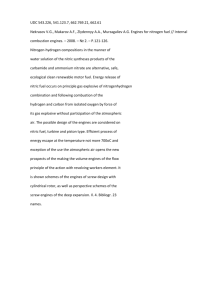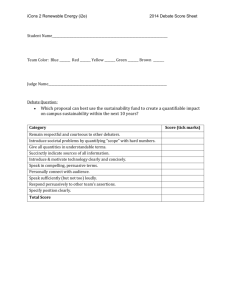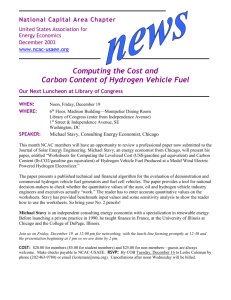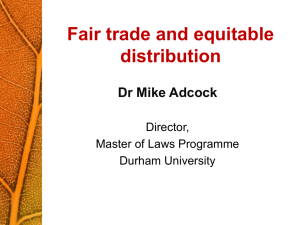Technology White Papers
advertisement
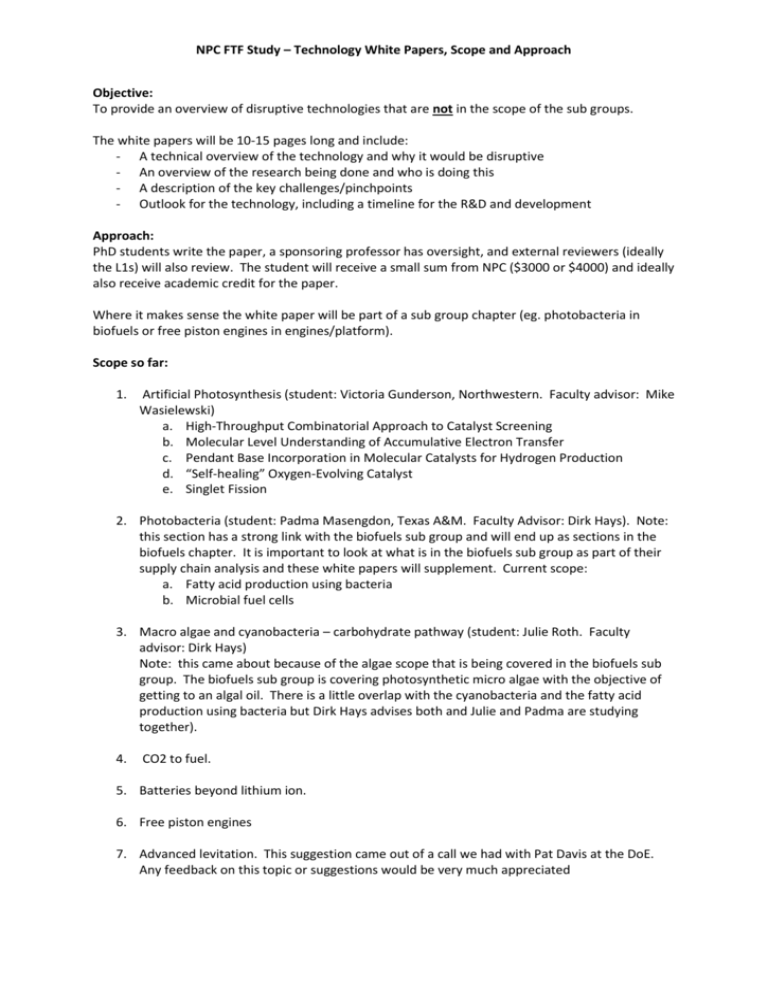
NPC FTF Study – Technology White Papers, Scope and Approach Objective: To provide an overview of disruptive technologies that are not in the scope of the sub groups. The white papers will be 10-15 pages long and include: - A technical overview of the technology and why it would be disruptive - An overview of the research being done and who is doing this - A description of the key challenges/pinchpoints - Outlook for the technology, including a timeline for the R&D and development Approach: PhD students write the paper, a sponsoring professor has oversight, and external reviewers (ideally the L1s) will also review. The student will receive a small sum from NPC ($3000 or $4000) and ideally also receive academic credit for the paper. Where it makes sense the white paper will be part of a sub group chapter (eg. photobacteria in biofuels or free piston engines in engines/platform). Scope so far: 1. Artificial Photosynthesis (student: Victoria Gunderson, Northwestern. Faculty advisor: Mike Wasielewski) a. High-Throughput Combinatorial Approach to Catalyst Screening b. Molecular Level Understanding of Accumulative Electron Transfer c. Pendant Base Incorporation in Molecular Catalysts for Hydrogen Production d. “Self-healing” Oxygen-Evolving Catalyst e. Singlet Fission 2. Photobacteria (student: Padma Masengdon, Texas A&M. Faculty Advisor: Dirk Hays). Note: this section has a strong link with the biofuels sub group and will end up as sections in the biofuels chapter. It is important to look at what is in the biofuels sub group as part of their supply chain analysis and these white papers will supplement. Current scope: a. Fatty acid production using bacteria b. Microbial fuel cells 3. Macro algae and cyanobacteria – carbohydrate pathway (student: Julie Roth. Faculty advisor: Dirk Hays) Note: this came about because of the algae scope that is being covered in the biofuels sub group. The biofuels sub group is covering photosynthetic micro algae with the objective of getting to an algal oil. There is a little overlap with the cyanobacteria and the fatty acid production using bacteria but Dirk Hays advises both and Julie and Padma are studying together). 4. CO2 to fuel. 5. Batteries beyond lithium ion. 6. Free piston engines 7. Advanced levitation. This suggestion came out of a call we had with Pat Davis at the DoE. Any feedback on this topic or suggestions would be very much appreciated NPC FTF Study – Technology White Papers, Scope and Approach 8. HCNG (student: Peter Thompson, UC Berkeley. Advisor: Westport's Dr. Sandeep Munshi). We also wanted to ask Rob Dibble to be a faculty advisor but he has not been responsive). This was a joint request by the Natural Gas and Hydrogen teams 9. Separations (being done by Jose Bravo, Shell’s Chief Scientist for Separations). Others under consideration - came up on Dec 3 LNG Vehicle safety Congestion technology Home refuelling hydrogen planes Technology Scope in Sub Groups (the scope will NOT be white papers but be covered in the technology pinchpoint analysis done in the context of the supply chains- we have noted the relevant white papers) Engines/Platforms Direct injection variable valves mild hybridisation light-weighting low rolling resistance aerodynamic improvements flex fuel hardening downsizing and turbo-charging advanced transmissions diesel strong hybridisation HCCI diesel after treatment (emissions control) stratified charge lean burn White papers Free piston engines Smart vehicles to avoid congestion Biofuels Feedstock Pretreatment technologies Enzymes Biochemical/biotechnology fuel types Ethanol (as above) Butanol (ABE and/or variation of the traditional ABE to produce n-butanol) Isobutanol (assume the is the GM yeast process being developed by Butamax and Gevo) Isoprenoids (Amyris and others) Thermal-Chemistry fuel types Pyrolysis oil Mixed alcohols (Several platforms for mixed alcohols based on current catalytic technology Hydrocarbons (aqueous phase reforming- Virent- and other work going on in universities) Biodiesel Green diesel (Hydrotreated Renewable Diesel or NEXtBTL) Hydrothermal liquefaction— (PNNL and in Europe) BtL/CBtL – (not be covered in detail by the biofuel group) Hybrid processes like mixture of microbes and gasification (e.g. Coskata, Ineos) NPC FTF Study – Technology White Papers, Scope and Approach Photosynthetic microalgae- open pond Photosynthetic microalgae- bioreactor White papers Separations Photobacteria Macro algae/cyanobacteria Natural Gas Refuelling infrastructure LDV and HDV (particularly performance / reliability / durability) Spark Ignition, Compression Ignition (fumigated gas and directed injected gas) Cryogenic pumps for fuel dispensing and on board fuel supply Energy Efficiency: HCCI, turbocharging, etc. CNG, LNG, Bio Methane fuel sources Tanks (change shape, new materials, etc.) Includes venting & onboard storage White papers HCNG LNG safety (TBD) Electric Battery – Li ion L1/L2/L3 Charging EVSE Grid integration Communications Electric motors/power electronics (link w/ engines/platforms) White papers Batteries beyond li ion Distributed Charging and Storage Vehicle to Grid Integration with renewables Hydrogen Vehicles Fuel Cell System Power Electronics Onboard Reforming Onboard Storage Hydrogen ICE Infrastructure Centralized Production o Renewable o Non-renewable Distributed Production o Renewable o Non-renewable Home Fueling (may or may not be a white paper) o Renewable Production NPC FTF Study – Technology White Papers, Scope and Approach o Non-renewable Production o Compression o Storage o Dispensing Compression Storage Pre-cooling Dispensing Distribution o Trucking, Rail, Pipelines White papers HCNG On-board reforming (TBD) Plug-In FCVs to be addressed by Electricity Subgroup (TBD) 2-wheelers, air, marine and rail hydrogen efforts (TBD) Airplanes (TBD)

